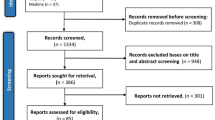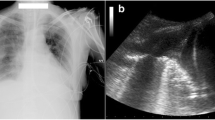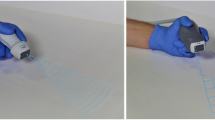Abstract
Purpose
There is lack of validated methods for quantifying the size of pleural effusion from standard transthoracic (TTE) windows. The purpose of this study is to determine whether pleural effusion (Peff) measured from routine two-dimensional (2D) TTE views correlate with chest radiograph (CXR).
Materials and methods
We retrospectively identified all inpatients who underwent a TTE and CXR within 2 days in a large tertiary care center. Peff was measured on TTE from parasternal long axis (PLAX), apical four-chamber (A4C), and subcostal views and on CXR. Logistic regression models were used determine optimal cut points to predict moderate or greater Peff.
Results
In 200 patients (mean age 69.3 ± 14.3 years, 49.5% female), we found statistically significant associations between Peff size assessed by all TTE views and CXR, with weak to moderate correlation (PLAX length: 0.21 (95% CI [0.05, 0.35]); PLAX depth: 0.21 (95% CI [0.05, 0.35]); A4C left: 0.31 (95% CI [0.13, 0.46]); A4C right: 0.39 (95% CI [0.17, 0.57]); subcostal: 0.38 (95% CI [0.07, 0.61]). The best TTE thresholds for predicting moderate or greater left-sided Peff on CXR was PLAX length left > = 8.6 cm (sensitivity 78%, specificity 54%, PPV 26%, and NPV 92%). The best TTE thresholds for predicting moderate or greater right-sided Peff on CXR was A4C right > = 2.6 cm (sensitivity 87%, specificity 60%, PPV 37%, and NPV 94%).
Conclusions
We identified statistically significant associations with Peff size measured on TTE and CXR. The predictive ability of TTE to identify moderate or large pleural effusion is limited.


Similar content being viewed by others
References
Ercan S, Davutoglu V, Altunbas G, Inanc IH, Kaplan M, Oylumlu M, et al. Prognostic role of incidental pleural effusion diagnosed during echocardiographic evaluation. Clin Cardiol. 2014;37:115–8.
DeBiasi E, Puchalski J. Pleural effusions as markers of mortality and disease severity: a state-of-the-art review. Curr Opin Pulm Med. 2016. https://doi.org/10.1097/MCP.0000000000000278.
Kataoka H. Pericardial and pleural effusions in decompensated chronic heart failure. Am Heart J. 2000;139:918–23.
Alkhouli M, Sandhu P, Wiegers SE, Patil P, Panidis J, Pursnani A. Extracardiac findings on routine echocardiographic examinations. J Am Soc Echocardiography. 2014;27:540–6.
Lewandowski BJ, Jaffer NM, Winsberg F. Relationship between the pericardial and pleural spaces in cross-sectional imaging. J Clin Ultrasound. 1981;9:271–4.
Light R, Lee Y. Textbook of Pleural Diseases Second Edition. 2nd ed. Boca Raton: CRC Press; 2008.
Tasci O, Hatipoglu ON, Cagli B, Ermis V. Sonography of the chest using linear-array versus sector transducers: correlation with auscultation, chest radiography, and computed tomography. J Clin Ultrasound. 2016;44:383–9.
Mitchell C, Rahko PS, Blauwet LA, Canaday B, Finstuen JA, Foster MC, et al. Guidelines for performing a comprehensive transthoracic echocardiographic examination in adults: recommendations from the American society of echocardiography. J Am Soc Echocardiogr. 2019;32:1–64.
Haaz WS, Mintz GS, Kotler MN, Parry W, Segal BL. Two dimensional echocardiographic recognition of the descending thoracic aorta: value in differentiating pericardial from pleural effusions. Am J Cardiol. 1980;46:739–43.
Mammarappallil JG, Anderson SA, Danelson KA, Stitzel JA, Chiles C. Estimation of pleural fluid volumes on chest radiography using computed tomography volumetric analysis. J Thoracic Imaging. 2015;30:336–9.
Canary JD, Blizzard L, Barry RP, Hosmer DW, Quinn SJ. Summary goodness-of-fit statistics for binary generalized linear models with noncanonical link functions. Biometrical J. 2016;58:674–90.
Zocchi L. Physiology and pathophysiology of pleural fluid turnover. Eur Respir J. 2002. https://doi.org/10.1183/09031936.02.00062102.
Noppen M, De Waele M, Li R, Vander GK, D’Haese J, Gerlo E, et al. Volume and cellular content of normal pleural fluid in humans examined by pleural lavage. Am J Respir Critical Care Med. 2000;162:1023–6.
Diaz-Guzman E, Dweik RA. Diagnosis and management of pleural effusions: a practical approach. Compr Ther. 2007. https://doi.org/10.1007/s12019-007-8016-5.
Sahn SA. The differential diagnosis of pleural effusions. West J Med. 1982;137(2):99–108.
Ekpe E, Essien I, Idongesit U. Significant pleural effusion in congestive heart failure necessitating pleural drainage. Nigerian J Cardiol. 2015;12:106.
Sikora K, Perera P, Mailhot T, Mandavia D. Ultrasound for the detection of pleural effusions and guidance of the thoracentesis procedure. ISRN Emerg Med. 2012;2012:1–10.
Tsai TH, Yang PC. Ultrasound in the diagnosis and management of pleural disease. Curr Opin Pulm Med. 2003. https://doi.org/10.1097/00063198-200307000-00007.
Ferreira AC, Mauad Filho F, Braga T, Fanstone GD, Bumlai Chodraui IC, Onari N. The role of ultrasound in the assessment of pleural effusion. Radiol Bras. 2006. https://doi.org/10.1590/S0100-39842006000200014.
Ibitoye BO, Idowu BM, Ogunrombi AB, Afolabi BI. Ultrasonographic quantification of pleural effusion: comparison of four formulae. Ultrasonography. 2018;37:254–60.
Urman MK, Pollick C. Routine echocardiographic views miss significant pleural effusions. Echocardiography. 1995;12:449–55.
Picard MH, Adams D, Bierig SM, Dent JM, Douglas PS, Gillam LD, et al. American society of echocardiography recommendations for quality echocardiography laboratory operations. J Am Soc Echocardiogr. 2011. https://doi.org/10.1016/j.echo.2010.11.006.
D’Cruz IA, Kanuru N. Echocardiography of serous effusions adjacent to the heart. Echocardiography. 2001. https://doi.org/10.1046/j.1540-8175.2001.00445.x.
Jakobsen C-J, Torp P, Sloth E. Perioperative feasibility of imaging the heart and pleura in patients with aortic stenosis undergoing aortic valve replacement. Eur J Anaesthesiol. 2007;24:589–95.
Bertin F, Deslauriers J. Anatomy of the pleura: reflection lines and recesses. Thorac Surg Clin. 2011. https://doi.org/10.1016/j.thorsurg.2010.12.002.
Choi YW, Shepard JAO, Kim J, Jeon SC, Park CK, Heo JN, et al. Left costomediastinal recess of the pleura, the potential pleural space anterior to the heart. J Comput Assist Tomogr. 2011;35:135–40.
Lang RM, Badano LP, Victor MA, Afilalo J, Armstrong A, Ernande L, et al. Recommendations for cardiac chamber quantification by echocardiography in adults: an update from the American Society of Echocardiography and the European Association of Cardiovascular Imaging. J Am Soc Echocardiogr. 2015;28:1-39.e14.
Mohamed AA, Arifi AA, Omran A. The basics of echocardiography. J Saudi Heart Assoc. 2010;22:71–6.
Funding
This research did not receive any specific grant from funding agencies in the public, commercial, or not-for-profit sectors.
Author information
Authors and Affiliations
Corresponding author
Ethics declarations
Conflict of interests
Soohyun A. Chang, Jeffrey Yim, Darwin F. Yeung, Eric C. Sayre, Ken Gin, John Jue, Parvathy Nair, Michael Y.C. Tsang, Christina Luong, and Teresa S.M. Tsang declare no conflict of interest.
Additional information
Publisher's Note
Springer Nature remains neutral with regard to jurisdictional claims in published maps and institutional affiliations.
Rights and permissions
Springer Nature or its licensor holds exclusive rights to this article under a publishing agreement with the author(s) or other rightsholder(s); author self-archiving of the accepted manuscript version of this article is solely governed by the terms of such publishing agreement and applicable law.
About this article
Cite this article
Yim, J., Chang, S.A., Yeung, D.F. et al. Quantification of pleural effusions by two-dimensional transthoracic echocardiography. J Echocardiogr 21, 33–39 (2023). https://doi.org/10.1007/s12574-022-00586-5
Received:
Revised:
Accepted:
Published:
Issue Date:
DOI: https://doi.org/10.1007/s12574-022-00586-5




